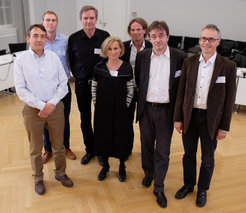Materials for the Technology of Tomorrow
The NOMAD European Center of Excellence is set to simplify the search for new materials and previously unknown properties of materials
New technological developments are practically always based on better, and often enough completely new, materials. This applies to the next generation of smartphones, fuel-efficient cars or powerful batteries for electric vehicles, as well as to catalysts for the production of methane or liquid fuels and high-performance solar cells. Thanks to the NOMAD (Novel Materials Discovery) European Center of Excellence, which officially commences work on the 1 November 2015, it should become easier to track down suitable materials for such disparate applications. Headed by Matthias Scheffler, Director at the Fritz Haber Institute of the Max Planck Society in Berlin, a team of scientists from eight research facilities and four high performance computer centers across the whole of Europe have joined forces. The Center of Excellence will be supported with five million euros over the next three years as part of the EU Horizon 2020 research framework program.

Around 200,000 different materials are known today, starting with innumerable alloys and through to organic compounds such as polymers and hybrid systems of organic and inorganic substances. But that is only a fraction of all possible compounds. “Many materials which could be scientifically, but also technologically interesting, are still completely unknown to us”, says Max Planck Director Matthias Scheffler. “And even with the known materials many exciting properties have so far remained hidden”. To change this is one his and his research team’s goals. The Nomad Center of Excellence team includes Claudia Draxl, Professor at the Humboldt University in Berlin and Max Planck Fellow at the Fritz Haber Institute, Angel Ruio, Director at the Max Planck Institute for Structure and Dynamics of Matter in Hamburg, and Stefan Heinzel, Director of the Max Planck Computing and Data Facility in Garching. A workshop in the Max Planck Society’s Harnack House in Berlin marked the starting signal.
The foundation stone for the work of the European research association is formed by a database called Nomad-repository.eu, which is available to all based on Open Access principles. It is currently being established under the supervision of Matthias Scheffler and Claudia Draxl and funded by the annual featured project 2015 of the Supporting Members of the Max Planck Society. Researchers across the world supply fundamental physical parameters of known materials for the databank which have been calculated with the help of quantum mechanical methods, and thus make their work accessible to all, as well as comprehensible and usable for additional purposes.
Unknown compounds as suggestions for special applications

The data collection of the Nomad repository is the precondition for the work of the Nomad Center of Excellence. The Center’s researchers will now develop software to obtain information about materials from the raw data of the quantum mechanical calculations, which will be of direct use to users such as those from industry. “In this manner we want to create a comprehensive encyclopaedia of materials science, which will also be available to all”, says Matthias Scheffler.
The virtual reference work will, however, not only provide information about known compounds and their known properties. Rather, the encyclopaedia should make it possible to suggest a previously unknown material with the desired properties for a special application, or to bring to light previously unknown properties of known materials. For this purpose, the scientists of the Nomad consortium will develop methods and software which recognize connections between structure and properties among the numerous materials already known. “On the basis of these trends, the software should suggest still unknown compounds among the innumerable chemical combinations possible which may be considered for a special application”, Matthias Scheffler explains.
To prepare the data from quantum calculations and also to investigate previously unknown territory in materials science, the Nomad researchers are pursuing two main approaches: on the one hand, they use data mining techniques to discover patterns in large quantities of data. This enables predictions about previously unknown substances or unknown properties. On the other hand, the scientists are further developing machine learning procedures for materials science, including those known as compressed sensing. This mathematical method picks out those of the innumerable information items in the NOMAD database which are relevant for a special analysis. This uses a principle similar to that of programs that compress video or audio files.
The information should be easy to grasp visually
“Ultimately, a user from an academic or industrial area, for example, will only have to enter the desired property of a material, such as an absorption range for a solar cell, which of course should also be robust and not contain any toxic elements”, explains Matthias Scheffler. The encyclopaedia would then indicate chemical compounds which are most suitable for the particular purpose. The Nomad researchers will also develop programs to prepare the mass of data in the depot visually so that users can grasp the contained information as easily as possible. For instance, users should be able to follow visually how a catalyst makes and breaks chemical bonds to a partner in a reaction.
Chemical bonds and in general the behaviour of the electrons in a material determine its properties. The Nomad encyclopaedia will therefore mainly contain information about the electron structure of the known materials - and that in enormous quantities. “Thanks to the combination of Big Data and new software, researchers should receive exactly the materials science information that is relevant for them”, says Matthias Scheffler.

